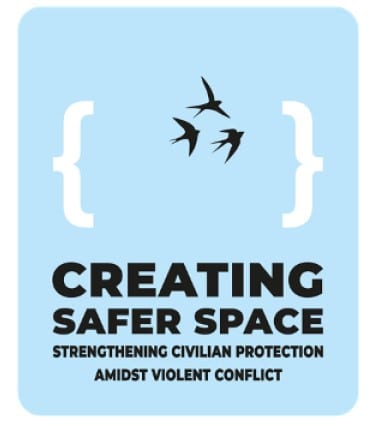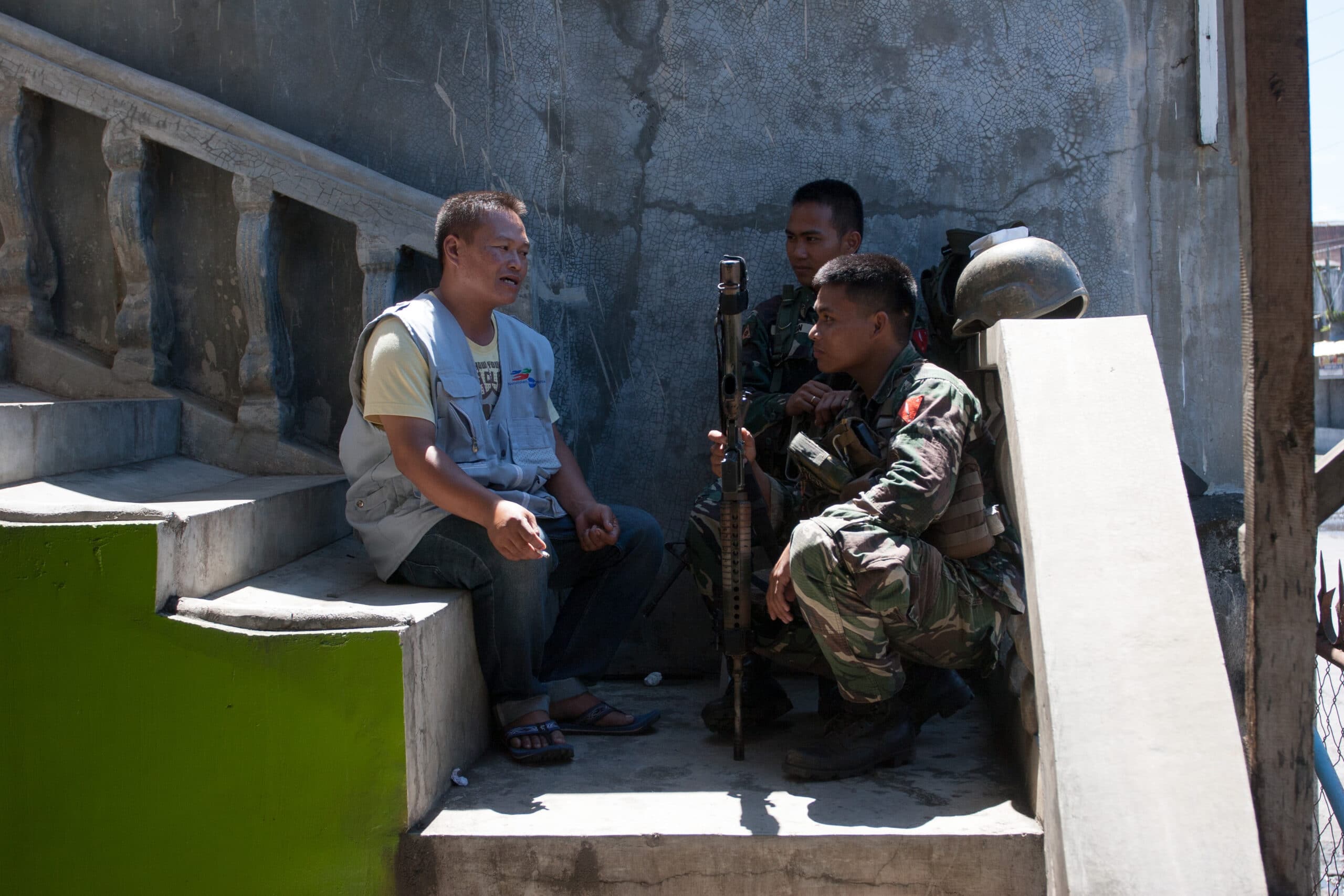Research & Evaluations
Publications
Research & Evaluations
We’ve known for a long time that Unarmed Civilian Protection works because of the testimonies of communities and field teams around the world. In addition, the published evidence for Unarmed Civilian Protection as a viable and effective approach is strong, and growing stronger. The below provide an overview of research on Unarmed Civilian Protection practices across a range of contexts.
Research and Evaluations
- Gaps in Formal Education in Iraq | Iraq | December 2021
A research study conducted by the Education Consortium of Iraq (ECI) – comprised of the Norwegian Refugee Council, Save the Children, Mercy Corps, and NP– has identified areas to improve in education infrastructure, personnel, and reintegration of students into the formal system across six governorates.
Link to the Report - Building Peace Changing Lives: Role and Participation of Women in Peace and Security in Myanmar, Philippines and Thailand | Philippines | March 23, 2021
This study, conducted by NP Philippines in collaboration with the Canada Fund for Local Initiatices (CFLI). This study presents lessons learned and conclusions to highlight the significant gains of women peacebuilding and emphasize the need for concrete actions to implement and institutionalize WPS agenda in the three countries in particular and in ASEAN in general.
Link: Report
Link: Policy Brief - Strengthening the Safe School Community | United States | October 2020
Exploring the Work and Objectives of School Safety and Security Specialists. Conducted by Rand Engel for Nonviolent Peaceforce & Nonviolence International.
Link to Paper -
Women Contributing to Peace | Myanmar | March 6, 2019
The study, conducted NP in partnership with the United States Agency for International Development (USAID), collected data from August 2018 to January 2019. The map, intended as a quick guide, lists 674 women from 383 organizations who contribute to peace building.
Link: Electronic copies of the maps, along with additional information about women contributing to peace in Myanmar
Link: Press release from U.S. Embassy in Burma
- "Community engagement with armed actors in South Sudan: reducing violence and protection risks," (Gemma Davies and Leigh Mayhew with The Bridge Network; HPG Working Paper) - February 2024
- "'Peace' in the Humanitarian-Development-Peace Nexus: Good Practices and Recommendations," Civil Society Dialogue Network (CSDN) Discussion Paper - October 2023
- "Protection Needs and Capacities of Youth: A Preliminary Report Exploring Youth Protection in Myanmar" - July 2018
- "Promoting Women’s Role in Peace Building and Gender Based Violence Prevention in South Sudan": Midterm Evaluation Report - October 2017
- "Implementing Civilian Protection in the United States: Lessons Learned from the Dakota Access Pipeline at Standing Rock, North Dakota" - December 2016 – March 2017
- "Civilians Protecting Civilians through Ceasefire Monitoring:" Civilian Ceasefire Monitoring in Myanmar 2012-2016 -- October 2016
- "Final Evaluation Report: Civilian Ceasefire Monitoring Project" by Swisspeace - January 2016
- Nonviolent Peaceforce South Sudan - One Year of Civil War (2013-2014)
- Mediateur Report, Canan Gündüz and Raul Torralba - Evaluation of the Nonviolent Peaceforce Project with the Civilian Protection Component of the International Monitoring Team in Mindanao, Philippines - Final Report. 6 May 2014
- Nine Years of Nonviolent Peaceforce in Sri Lanka. Lessons Learned in Implementing Unarmed Civilian Peacekeeping - By Christine Schweitzer, September 2012
- NP Evaluation in the Philippines, October 2011 - February 2012
- Nonviolent Peaceforce Evaluation of NP’s Project in Mindanao, Philippines REPORT by Dr. Cordula Reimann (2010)
- Unarmed Civilian Protection Updates, Challenges & Opportunities (2022)
- Global review of good practices in the field of unarmed civilian protection
- "Examining Unarmed Civilian Protection in the UN Context: A Complement and Contribution to POC," Consultation for Member States, New York (2019).
- “Unarmed Civilian Peacekeeping,” Documentation of a symposium, Bonn (2015).
- "What would the UN Peace Operations Panel Recommend if it were led by Women, Civil Society Organizations, and Local Actors Living in Conflict?" Event report, NGO CSW Forum Parallel Event, New York (2015).
- Doss, A. "Unarmed Civilian Peacekeeping: Has its Time Come?" Aide Mémoire, Geneva Briefing and Dialogue (2013).
- Cabactulan, L & C Coleman. "Broadening the concept of Peacekeeping: the Contribution of Civil Society to Unarmed Protection of Civilians." High-Level Briefing at the United Nations, New York (2012).
UCP Research Highlights
- Gray, Felicity. “'A different kind of weapon'?: Nonviolent action and the protection of civilians in violent conflict” The Australian National University, Canberra, 2023
- Gray, Felicity. "Relational R2P? Civilian-Led Prevention and Protection against Atrocity Crimes", Global Responsibility to Protect (published online ahead of print 2022).
- Gray, Felicity. “Chapter 11: ‘A Different Kind of Weapon’: Ethical Dilemmas and Nonviolent Civilian Protection." Wicked Problems: The Ethics of Action for Peace, Rights, and Justice, Oxford University Press, New York, 2022.
- Easthom, Tiffany. “Community Resiliency, Conflict, and COVID-19.” Peace Review 33, no.2 (2021): 263-269
- Oakley, Derek. “What Is the Relationship between the Situated Learning of Unarmed Civilian Protection Workers and Gendered Power Dynamics?” Lancaster University, Lancaster, 2020, p. 236.
- Julian, Rachel, "The Transformative Impact of Unarmed Civilian Protection," Global Society 34(1): 99-111, 2020.
- Pax Christi International, A Policymaker’s Tool for Effective, Nonviolent Strategies for Sustainable Peace," October 2021.
- Harley Henigson, “Community Engagement in UN Peacekeeping Operations: A People-Centered Approach to Protecting Civilians,” International Peace Institute, November 2020.
- McCarthy, Eli S., ed. A Just Peace Ethic Primer: Building Sustainable Peace and Breaking Cycles of Violence. Washington, DC: Georgetown University Press, 2020.
- Rachel Julian and Russell Gasser (2019) ‘Soldiers, Civilians and Peacekeeping – Evidence and False Assumptions’, International Peacekeeping 26(1): 22-54.
- Wallace, M.S. Security without Weapons: Rethinking Violence, Nonviolent Action, and Civilian Protection (Interventions). New York: Routledge, 2017.
- Furnari, Ellen. Wielding Nonviolence in the Midst of Violence: Case Studies of Good Practices in UCP. Norderstedt: Books on Demand, 2016
- "Unarmed Civilian Protection: The Methodology and Its Relevance for Norwegian Church-Based Organizations and Their Partners" by the Norwegian Ecumenical Peace Platform - October 2016
- Furnari, Ellen, Huibert Oldenhuis, and Rachel Julian. "Securing space for local peacebuilding: the role of international and national civilian peacekeepers." Peacebuilding 3, no. 3 (2015): 297-313.
- Julian, Rachel, and Christine Schweitzer. "The Origins and Development of Unarmed Civilian Peacekeeping." Peace Review 27, no. 1 (2014): 1-8.
- Rossi, Alessandro. “The Glass Ceiling for UCP in Inter-Governmental Organizations.” Peace Review 27, no. 1 (2014): 9-17.
- Eguren, Luis Enrique. “The Notion of Space in International Accompaniment.” Peace Review 27, no. 1 (2014): 18-24.Eguren, Luis Enrique. “The Notion of Space in International Accompaniment.” Peace Review 27, no. 1
(2014): 18-24. - Furnari, Ellen. “Relationships Are Critical for Peacekeeping.” Peace Review 27, no.1 (2014): 25-30
- Easthom, Tiffany. “The South Sudan Weapons Free Zone.” Peace Review 27, no.1 (2014): 31-36
- Wallis, Tim. “Saving Lives, Saving Souls.” Peace Review 27, no. 1 (2014): 37-42
- Engelbrecht, Georgi and Vidushi Kaushik. “Community-Based Protection Mechanisms.” Peace Review 27, no. 1 (2014): 43-51
- Gehrmann, Richard. Matt Grant and Samantha Rose. “Australian Unarmed Peacekeepers on Bougainville, 1997–2003.” Peace Review 27, no. 1 (2014): 52-60
- Venturi, Bernardo. "Mainstreaming Unarmed Civilian Peacekeeping." Peace Review 27, no. 1 (2014): 61-66.
- Beckman, Kara, and Solberg, Kenneth B. “Measuring the Impact of Unarmed Civilian Peacekeeping: A Pilot Study” (2013).
- Carrière, Rolf, Rachel Julian, Christine Schweitzer, and Tim Wallis. Civilian peacekeeping: a barely tapped resource. Edited by Christine Schweitzer. Belm-Vehrte: Sozio-Publ., 2010.
- Schweitzer, Christine. “Nonviolent Peaceforce Feasibility Study,” Feasibility Study, Hamburg/St. Paul, 2001.
- Felicity Gray (2022) 'Protection as connection: feminist relational theory and protecting civilians from violence in South Sudan', Journal of Global Ethics 18(1): 152-170.
- Jana Krause, Erin Kamler (2022) 'Ceasefires and Civilian Protection Monitoring in Myanmar', Global Studies Quarterly 2(1).
- Margaux Pinaud (2021) ‘Home-Grown Peace: Civil Society Roles in Ceasefire Monitoring’, International Peacekeeping 28(3): 470-495.
- Congo Research Group (2020), Building Relationships, Building Peace: The Role of Civilians and Civil Society in Preventing Mass Atrocities in the Democratic Republic of the Congo, Washington D.C.: United State Holocaust Memorial Museum.
- Peris Jones and Wangui Kimari (2019) ‘Security beyond the men: Women and their everyday security apparatus in Mathare, Nairobi’, Urban Studies 56(9): 1835-1849.
- Joseph Bock et al. (2019) Halting Hate: How to Use the Interruption Model to Counter Hate-Motivated Violence, American Arbitration Association.
- Jana Krause (2018) Resilient Communities: Non-Violence and Civilian Agency in Communal War, Cambridge: Cambridge University Press.
- Nerve Macaspac (2019) ‘Insurgent Peace: Community-Led Peacebuilding of Indigenous Peoples in Sagada, Philippines’, Geopolitics 24(4): 839-877.
- Oliver Kaplan (2017) Resisting War: How Communities Protect Themselves, Cambridge: Cambridge University Press.
- Veronique Dudouet (2017) Powering to Peace: Integrated Civil Resistance and Peacebuilding Strategies, International Center on Nonviolent Conflict, vol. 1.
- Landon Hancock (2016) ‘Agency and peacebuilding: The promise of local zones of peace’, Peacebuilding, 5(3), 255–269.
- Jeffrey A. Butts (et al.) (2015) ‘Cure violence: A public health model to reduce gun violence’, Annual Review of Public Health (36): 39–53.
- Georgi Engelbrecht and Vidushi Kaushik (2015) ‘Community-based protection mechanisms’, Peace Review 27(1), 43–51.
- Sara Koopman (2014) ‘Making space for peace: International protective accompaniment in Colombia’, in F. McConnell, N. Megoran, & P. Williams (eds.), Geographies of peace: New approaches to boundaries, diplomacy and conflict resolution, London/New York: IB Tauris. 109–130.
UCP Research Database

Creating Safer Space
User-friendly way of finding the latest research on unarmed civilian protection, community self-protection and related topics.
Monthly Newsletter
Stay Informed
More than 700 people across 10+ countries have trained 26,000 individuals in unarmed civilian protection. Join us today to build a culture of global peace in more communities and across multiple generations — as a donor, a volunteer, a team member, or an independent researcher. Sign-up now to receive updates on events, NP’s work on the ground, career opportunities, and more.
SUBSCRIBE
